
The Second Intermediate Period dates from 1700 to 1550 BC. It marks a period when ancient Egypt was divided into smaller dynasties for a second time, between the end of the Middle Kingdom and the start of the New Kingdom. The concept of a Second Intermediate Period generally includes the 13th through to the 17th dynasties, however there is no universal agreement in Egyptology about how to define the period.
The Eighth Dynasty of ancient Egypt is a poorly known and short-lived line of pharaohs reigning in rapid succession in the early 22nd century BC, likely with their seat of power in Memphis. The Eighth Dynasty held sway at a time referred to as the very end of the Old Kingdom or the beginning of the First Intermediate Period. The power of the pharaohs was waning while that of the provincial governors, known as nomarchs, was increasingly important, the Egyptian state having by then effectively turned into a feudal system. In spite of close relations between the Memphite kings and powerful nomarchs, notably in Coptos, the Eighth Dynasty was eventually overthrown by the nomarchs of Heracleopolis Magna, who founded the Ninth Dynasty. The Eighth Dynasty is sometimes combined with the preceding Seventh Dynasty, owing to the lack of archeological evidence for the latter which may be fictitious.

Nynetjer is the Horus name of the third pharaoh of the Second Dynasty of Egypt during the Early Dynastic Period. Archaeologically, Nynetjer is the best attested king of the entire dynasty. Direct evidence shows that he succeeded Raneb on the throne. What happened after him is much less clear as historical sources and archaeological evidences point to some breakdown or partition of the state.

The Sixteenth Dynasty of ancient Egypt was a dynasty of pharaohs that ruled the Theban region in Upper Egypt for 70 years.
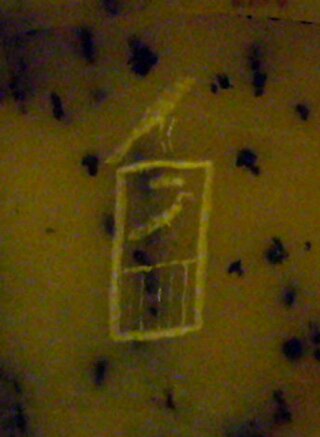
Khaba was a pharaoh of Ancient Egypt, active during the 3rd Dynasty of the Old Kingdom period. The exact time during which Khaba ruled is unknown but may have been around 2670 BC, and almost definitely towards the end of the dynasty.

Nebra or Raneb is the Horus name of the second early Egyptian king of the 2nd Dynasty. The exact length of his reign is unknown since the Turin canon is damaged and the year accounts are lost. Manetho suggests that Nebra's reign lasted 39 years, but Egyptologists question Manetho's view as a misinterpretation or exaggeration of information that was available to him. They credit Nebra with either a 10- or 14-year rule.

Weneg, also known as Weneg-Nebty, is the throne name of an early Egyptian king, who ruled during the Second Dynasty. Although his chronological position is clear to Egyptologists, it is unclear for how long King Weneg ruled. It is also unclear as to which of the archaeologically identified Horus-kings corresponds to Weneg.
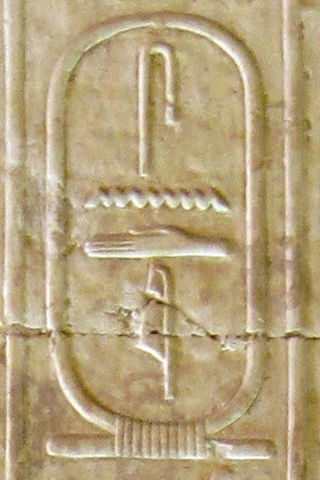
Senedj was an early Egyptian king (pharaoh), who may have ruled during the 2nd Dynasty. His historical standing remains uncertain. His name is included in the kinglists of the Ramesside era, although it is written in different ways: While the Abydos King List imitates the archaic form, the Royal Canon of Turin and the Saqqara King List form the name with the hieroglyphic sign of a plucked goose.
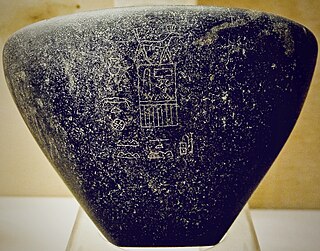
Seth-Peribsen is the serekh name of an early Egyptian monarch (pharaoh), who ruled during the Second Dynasty of Egypt. His chronological position within this dynasty is unknown and it is disputed who ruled both before and after him. The duration of his reign is also unknown.
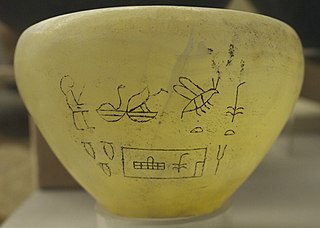
Semerkhet is the Horus name of an early Egyptian king who ruled during the First Dynasty. This ruler became known through a tragic legend handed down by the historian Manetho, who reported that a calamity of some sort occurred during Semerkhet's reign. The archaeological records seem to support the view that Semerkhet had a difficult time as king and some early archaeologists questioned the legitimacy of Semerkhet's succession to the Egyptian throne.

Sekhemib-Perenma'at, is the Horus name of an early Egyptian king who ruled during the 2nd Dynasty. Similar to his predecessor, successor or co-ruler Seth-Peribsen, Sekhemib is contemporarily well attested in archaeological records, but he does not appear in any posthumous document. The exact length of his reign is unknown and his burial site has yet to be found.

Nebka is the throne name of an ancient Egyptian pharaoh of the Third Dynasty during the Old Kingdom period, in the 27th century BCE. He is thought to be identical with the Hellenized name Νεχέρωχις recorded by the Egyptian priest Manetho of the much later Ptolemaic period.

Nimaathap was an ancient Egyptian queen consort at the transition time from 2nd Dynasty to 3rd Dynasty. Nimaathap may have acted as regent for her son Djoser.
Hudjefa is an ancient Egyptian word meaning "missing" or "erased". It was used by the royal scribes of the Ramesside era during the Nineteenth Dynasty of Egypt, when the scribes compiled king lists such as the Abydos King List, the royal table of Sakkara and the Royal Canon of Turin when the name of a deceased pharaoh was unreadable, damaged, or completely erased.
Thamphthis is the hellenized name of an ancient Egyptian ruler (pharaoh) of the 4th Dynasty in the Old Kingdom, who may have ruled under the name Djedefptah for between two and nine years. His original Egyptian name is lost, but it may have been Djedefptah or Ptahdjedef according to William C. Hayes. Thamphthis is one of the shadowy rulers of the Old Kingdom, since he is completely unattested in contemporary sources. For this reason, his historical figure is discussed intensely by historians and Egyptologists.

Neferkasokar was an Ancient Egyptian king (pharaoh) who may have ruled in Egypt during the 2nd Dynasty. Very little is known about him, since no contemporary records about him have been found. Rather his name has been found in later sources.

Wadjenes, also known as Wadjlas, Ougotlas and Tlas, was an early Egyptian king who may have ruled during the 2nd Dynasty. Since the name form "Wadjenes" is not contemporarily attested as the name of a king, but frequently appears in Ramesside kinglists, Egyptologists to this day are trying to connect Wadjenes with contemporary Horus-kings.
Hudjefa is the pseudonym for a 2nd Dynasty pharaoh as reported on the Turin canon, a list of kings written during the reign of Ramses II. Hudjefa is now understood to mean that the name of the king was already missing from the document from which the Turin canon was copied. The length of the reign associated to Hudjefa on the canon is 11 years. Because of the position of Hudjefa on the Turin list, he is sometimes identified with a king Sesochris reported in the Aegyptiaca, a history of Egypt written by the Egyptian priest Manetho in the 3rd century BC. Manetho credits this pharaoh with 48 years of reign. Egyptologists have attempted to relate Hudjefa with archaeologically attested kings of the period, in particular Seth-Peribsen.

Sneferka was an early Egyptian king who may have ruled at the end of the 1st Dynasty. The exact length of his reign is unknown, but thought to have been very short and his chronological position is unclear.
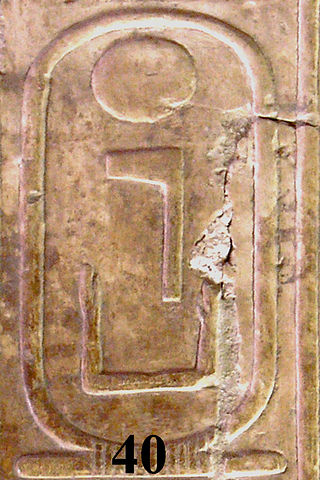
Netjerkare Siptah was an ancient Egyptian pharaoh, the seventh and last ruler of the Sixth Dynasty. Alternatively some scholars classify him as the first king of the Seventh or Eighth Dynasty. As the last king of the 6th Dynasty, Netjerkare Siptah is considered by some Egyptologists to be the last king of the Old Kingdom period.















